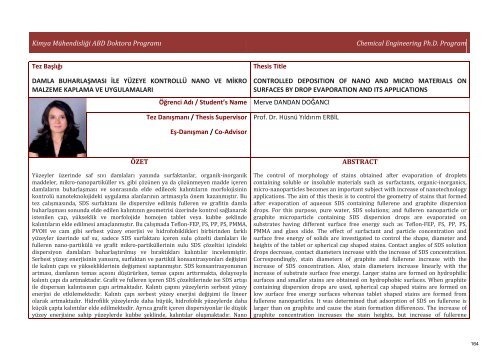GTÜ FBE Lisansüstü Programlar ve Tez Özetleri
You also want an ePaper? Increase the reach of your titles
YUMPU automatically turns print PDFs into web optimized ePapers that Google loves.
Kimya Mühendisliği ABD Doktora Programı<br />
Chemical Engineering Ph.D. Program<br />
<strong>Tez</strong> Başlığı<br />
Thesis Title<br />
DAMLA BUHARLAŞMASI İLE YÜZEYE KONTROLLÜ NANO VE MİKRO<br />
MALZEME KAPLAMA VE UYGULAMALARI<br />
Öğrenci Adı / Student’s Name Mer<strong>ve</strong> DANDAN DOĞANCI<br />
CONTROLLED DEPOSITION OF NANO AND MICRO MATERIALS ON<br />
SURFACES BY DROP EVAPORATION AND ITS APPLICATIONS<br />
<strong>Tez</strong> Danışmanı / Thesis Supervisor<br />
Prof. Dr. Hüsnü Yıldırım ERBİL<br />
Eş-Danışman / Co-Advisor<br />
ÖZET<br />
Yüzeyler üzerinde saf sıvı damlaları yanında surfaktanlar, organik-inorganik<br />
maddeler, mikro-nanopartiküller vs. gibi çözünen ya da çözünmeyen madde içeren<br />
damlaların buharlaşması <strong>ve</strong> sonrasında elde edilecek kalıntıların morfolojisinin<br />
kontrolü nanoteknolojideki uygulama alanlarının artmasıyla önem kazanmıştır. Bu<br />
tez çalışmasında, SDS surfaktanı ile dispersiye edilmiş fulleren <strong>ve</strong> grafitin damla<br />
buharlaşması sonunda elde edilen kalıntının geometrisi üzerinde kontrol sağlanarak<br />
istenilen çap, yükseklik <strong>ve</strong> morfolojide homojen tablet <strong>ve</strong>ya kubbe şeklinde<br />
kalıntıların elde edilmesi amaçlanmıştır. Bu çalışmada Teflon-FEP, FS, PP, PS, PMMA,<br />
PVOH <strong>ve</strong> cam gibi serbest yüzey enerjisi <strong>ve</strong> hidrofobiklikleri birbirinden farklı<br />
yüzeyler üzerinde saf su, sadece SDS surfaktanı içeren sulu çözelti damlaları ile<br />
fulleren nano-partikülü <strong>ve</strong> grafit mikro-partiküllerinin sulu SDS çözeltisi içindeki<br />
dispersiyon damlaları buharlaştırılmış <strong>ve</strong> bıraktıkları kalıntılar incelenmiştir.<br />
Serbest yüzey enerjisinin yanısıra, surfaktan <strong>ve</strong> partikül konsantrasyonları değişimi<br />
ile kalıntı çapı <strong>ve</strong> yüksekliklerinin değişmesi saptanmıştır. SDS konsantrasyonunun<br />
artması, damlanın temas açısını düşürürken, temas çapını arttırmakta, dolayısıyla<br />
kalıntı çapı da artmaktadır. Grafit <strong>ve</strong> fulleren içeren SDS çözeltilerinde ise SDS artışı<br />
ile dispersan kalıntısının çapı artmaktadır. Kalıntı çapını yüzeylerin serbest yüzey<br />
enerjisi de etkilemektedir. Kalıntı çapı serbest yüzey enerjisi değişimi ile lineer<br />
olarak artmaktadır. Hidrofilik yüzeylerde daha büyük, hidrofobik yüzeylerde daha<br />
küçük çapta kalıntılar elde edilmektedir. Ayrıca grafit içeren dispersiyonlar ile düşük<br />
yüzey enerjisine sahip yüzeylerde kubbe şeklinde, kalıntılar oluşmaktadır. Nano<br />
ABSTRACT<br />
The control of morphology of stains obtained after evaporation of droplets<br />
containing soluble or insoluble materials such as surfactants, organic-inorganics,<br />
micro-nanoparticles becomes an important subject with increase of nanotechnology<br />
applications. The aim of this thesis is to control the geometry of stains that formed<br />
after evaporation of aqueous SDS containing fullerene and graphite dispersion<br />
drops. For this purpose, pure water, SDS solutions; and fulleren nanoparticle or<br />
graphite microparticle containing SDS dispersion drops are evaporated on<br />
substrates having different surface free energy such as Teflon-FEP, FS, PP, PS,<br />
PMMA and glass slide. The effect of surfactant and particle concentration and<br />
surface free energy of solids are in<strong>ve</strong>stigated to control the shape, diameter and<br />
heights of the tablet or spherical cap shaped stains. Contact angles of SDS solution<br />
drops decrease, contact diameters increase with the increase of SDS concentration.<br />
Correspondingly, stain diameters of graphite and fullerene increase with the<br />
increase of SDS concentration. Also, stain diameters increase linearly with the<br />
increase of substrate surface free energy. Larger stains are formed on hydrophilic<br />
surfaces and smaller stains are obtained on hydrophobic surfaces. When graphite<br />
containing dispersion drops are used, spherical cap shaped stains are formed on<br />
low surface free energy surfaces whereas tablet shaped stains are formed from<br />
fullerene nanoparticles. It was determined that adsorption of SDS on fullerene is<br />
larger than on graphite and cause the stain formation differences. The increase of<br />
graphite concentration increases the stain heights, but increase of fullerene<br />
164




